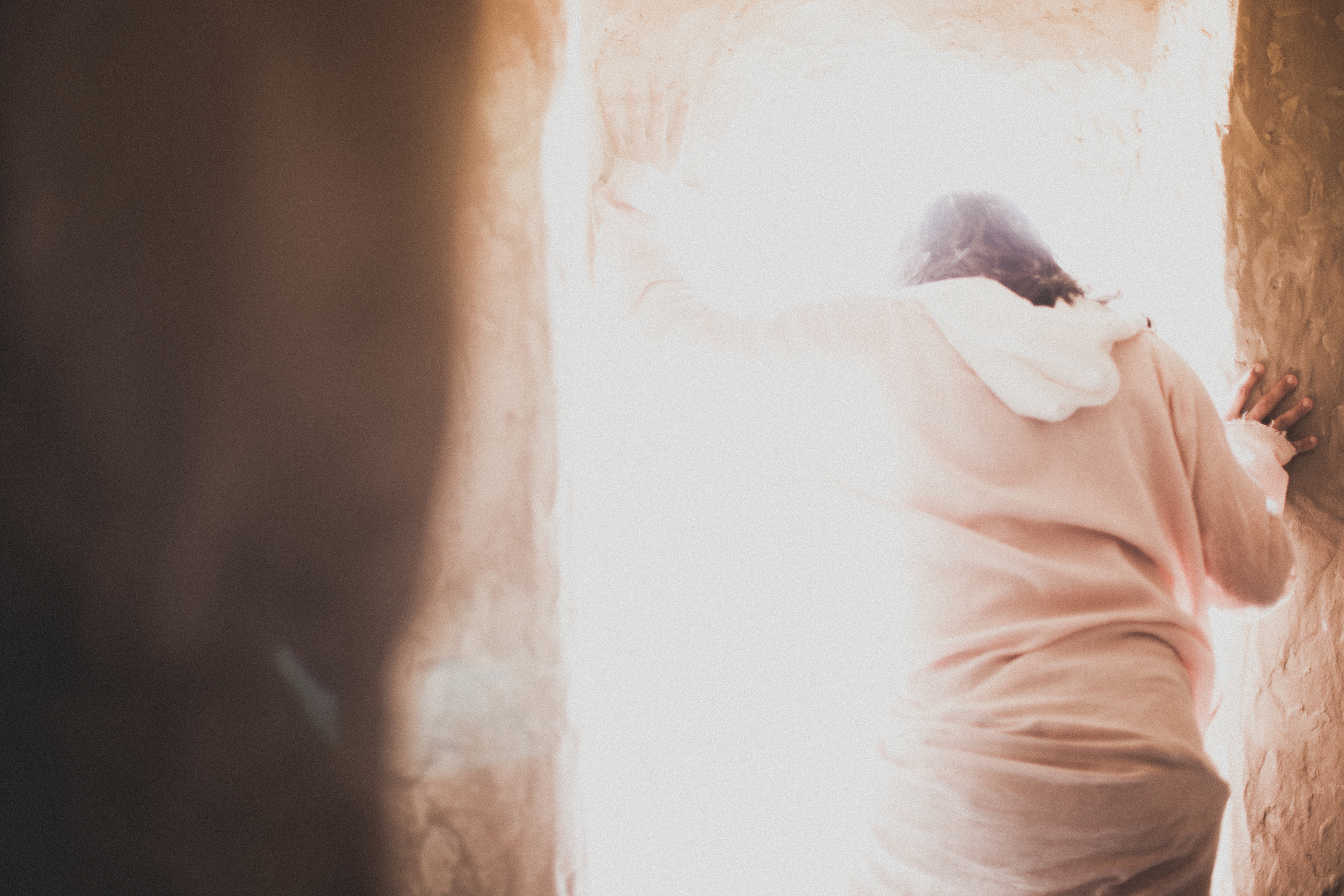The Resurrection was the most important miracle Jesus performed in the Bible. At that moment, Jesus overcame death by exiting the grave and proved that he was God. It’s so important that all four Gospels talked about it.
So what’s Jesus’ second-greatest miracle based on Gospel coverage?
That’s easy. The Feeding of the Five Thousand. Why? It, too, is recorded in all the Gospels. No other miracle besides those two are mentioned in all four.
Not walking on water.
Not healing the man born blind man.
Not raising a little girl to life.
Feeding five thousand people at one time received more exposure than bringing Lazarus back from the dead. It was that big of a deal.
And get this: It was so amazing, there was a sequel—the Feeding of the Four Thousand.
So how do you feed five thousand hungry people all at once?
Easy: You make fish sandwiches.
Here’s the recipe:
Bread + Fish = Fish Sandwich
This simple formula was the basis of the second-most important miracle in the history of the world.
So what happened during the multiplied feeding of the fish and bread that made it so noteworthy?
Let’s take a look at what happened.
The Feeding of the Five Thousand
The scene occurred in northern Israel, around the Sea of Galilee.[i] The Jewish Passover was nearing. Many groupies were following Jesus because he performed such amazing miracles. His teaching was like nothing they ever heard before.
It was late afternoon or early evening as Jesus and the apostles sat down on a mountainside, looking out over the thousands that had gathered. The apostles came to Jesus and said, “We stopped in a remote place and these people need to eat. Tell them to take off, hit the local village, and grab some dinner.”
Jesus listened to their request, then turned to Philip and said, “Why don’t you feed them?”
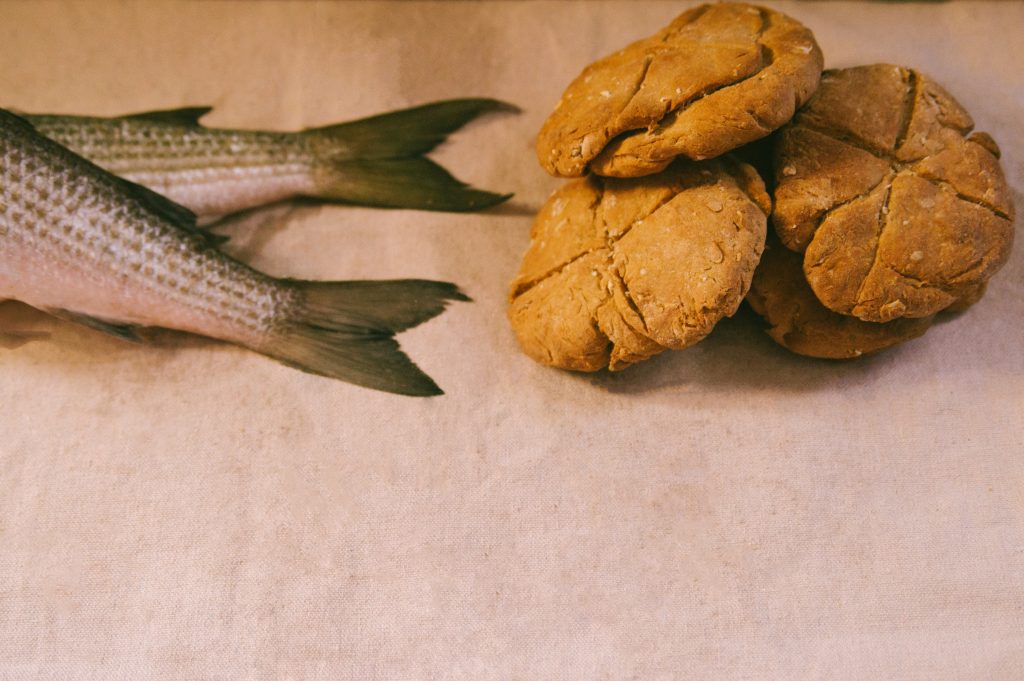
Philip, caught off guard, looked perplexed. The others felt the same. “Us? It’s going to take eight months’ wages to feed all these people! Do we look like we have that kind of money?”
Jesus leaned back, smiling. He loved to test his followers, especially when he knew the answer. “How much food can you find right now?”
The apostles worked the crowd, asking if anyone had any food. Andrew, Simon Peter’s brother, found a boy with five small barley loaves and two small fish. “This is all the food we can find. One kid was smart enough to bring his supper! That’s not going to be enough.”
“Sounds good,” Jesus said, sitting up and extending his hands. “Give them to me.”
The apostles handed over the paltry meal, barely enough to feed the thirteen of them.
Jesus motioned to the crowd. “Have them sit in groups of fifty to a hundred.”
The apostles shrugged, then mingled through the thousands of people, telling them to gather in groups.
Jesus took the five loaves and held them to the sky. “Thank you, Father, for what you have provided and what you are going to do!” He broke the bread. Then he handed the pieces to the apostles.
And more pieces . . .
And more pieces . . .
And even more pieces . . .
More and more bread came out of nowhere.
Then Jesus did the same with the fish.
The astonished disciples delivered the food to the hungry groups, who ate as much as they wanted. Thousands ate as much as they wanted—fish sandwiches for everyone!
When the people were all full and satisfied, Jesus told the apostles to pick up all the leftovers. “I don’t like anything going to waste.”
They did, filling twelve baskets with the pieces that originated from those five barley loaves.
In the end, five thousand men were fed, not counting the women and children.
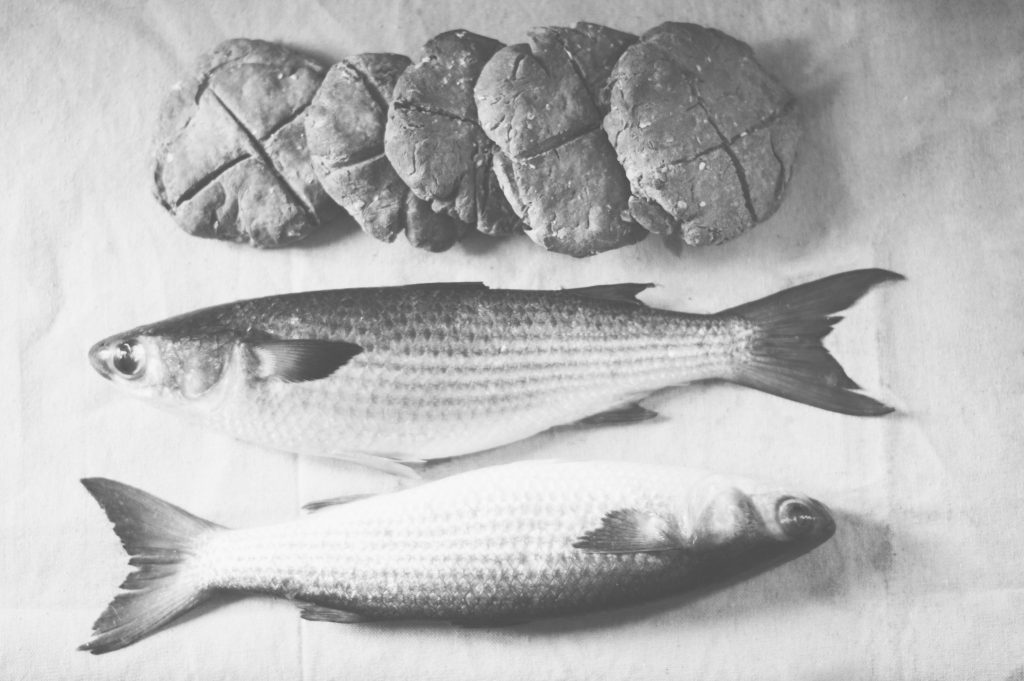
I had the opportunity to visit the area where some scholars believe this miracle occurred. My first stop took me to the Church of the Multiplication. Around the fourth or fifth century, people built a chapel to mark the spot many locals pointed to as the location of the Feeding of the Five Thousand. Invasions and wars leveled the original building; ancient mosaics were found there in 1932 and the Church of the Multiplication was rebuilt in its current form.[ii]
The most famous mosaic from the Church of the Multiplication depicts a basket (with what looks like bread inside) and fish on each side of it.
The church is near Tabgha, off the north/northwest corner of the Sea of Galilee. Tabgha comes from the Greek name Heptapegon or “seven springs” and was a place frequented by fishermen because fresh water springs spilled into the Sea of Galilee, making it a popular hangout for fish.[iii]
Nearby, you can find another church, the Church of the Primacy of Peter, a shrine that marks a possible location of Jesus calling Peter into ministry and where Jesus forgave Peter after the Resurrection. Those scenes happened while Peter and his men were fishing.[iv]
All this to say, the area was a popular hangout for Jesus—and fish.
Just before Luke told the feeding-of-the-fish-sandwiches story, he gave a clue to the location of the Feeding of the Five Thousand in Luke 9:10:
When the apostles returned, they reported to Jesus what they had done. Then he took them with him and they withdrew by themselves to a town called Bethsaida.
Bethsaida and the Church of the Multiplication are very close, easily within walking distance for first-century people, who were accustomed to walking. The town’s name means “house of fishing,” just like Bethlehem means “house of bread.”
Philip, Andrew, and Peter all came from Bethsaida (fish), while Jesus came from Bethlehem (bread).
Fish and bread. There’s that theme again.
I went to the ruins of Bethsaida with Avner Goren, an Israeli archaeologist made famous by Bruce Fieler’s excellent book and documentary Walking the Bible, to see the place where the miracle happened.
“Could Bethsaida have the resources to feed all these people?” I asked him, wondering if the apostles’ request to have them all go into town to grab a bite would be at all possible.
Avner sat down on the stone walls, once a home for someone who may have been fed by Jesus himself that day. “This town only had a population of around five thousand.”
There’s that number again. What did it mean? I took a guess. “So Jesus could be saying there’s enough of me to feed this whole town.”
Avner nodded, ever the teacher, pleased the student was making the connection. “That’s what it seems to be saying.”
Five thousand is a lot of people. Facebook sets five thousand as its limit on the number of people it thinks you can know. Five thousand feels incredible, impossible, miraculous even to Mark Zuckerberg in our modern electronic age. But Jesus made five thousand friends on one day.
It even gets better. Jesus fed even more than five thousand. Remember, the crowd counters in that day only counted the men. That means Jesus may have fed ten to fifteen thousand men, women, and children at one time!
Take that, Facebook!
Feeding five-thousand-plus people all at once got so much press because it was too good to be true.
So, like any box office sensation, it got a sequel.
The Feeding of the Four Thousand
While Jesus and his disciples walked along the Sea of Galilee, they came to a mountainside.[v] Word got out that some “miracle guy” was in town, so the town’s people laid the handicapped, the blind, and those who couldn’t hear or speak at the feet of Jesus, and he healed them.
Then, a huge party broke out, worshipping God.
Moved by the response, Jesus felt compassion for them. “We’ve been here for three days and had nothing to eat. I’ve healed their bodies, but let’s not starve them to death. Some of them traveled a long way and have to walk home. What do we have to eat?”
The disciples balked, but they knew the drill. They found seven loaves and a few small fish.
“Tell them to sit and take a load off their feet. Everyone needs to relax.”
The disciples did exactly as Jesus asked. They found him in that familiar position, holding the bread and fish to the sky and thanking God.
He broke them, just like before, and began handing them out to the disciples, piece by piece by piece by piece . . . until everyone was full of fish sandwiches.
In the end, seven basketfuls of broken pieces were left over.
This time, four thousand men ate, again not counting the women and children.
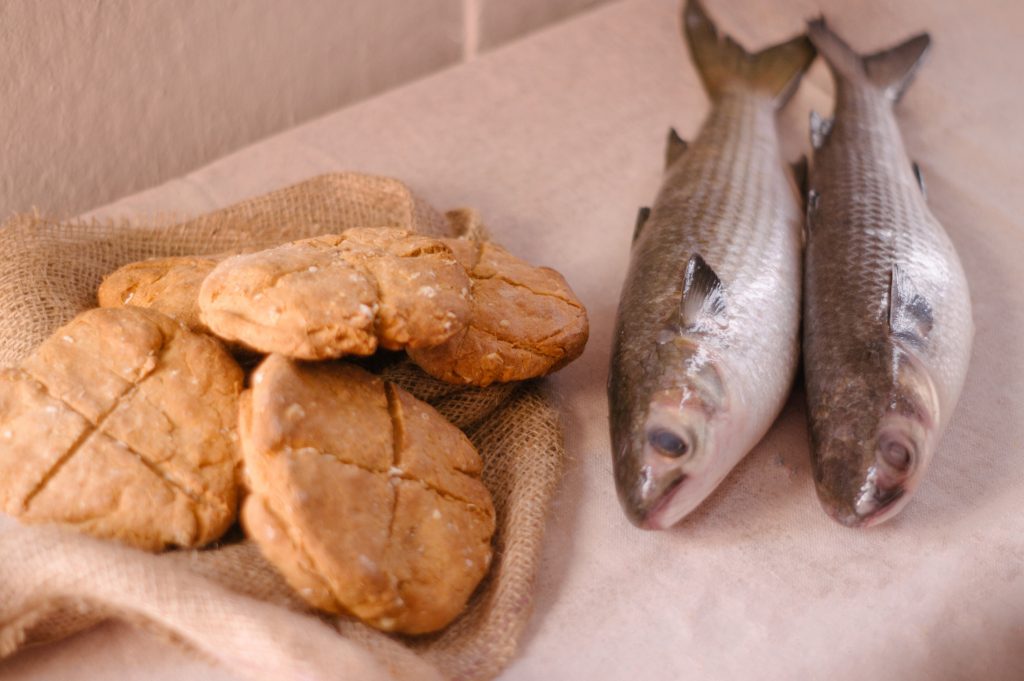
The time that passed between the two miracles is unclear. Both Matthew and Mark separate the feedings by only a chapter or two, and while neither Gospel is known for its chronology, this literary-proximity factor would date them close to each other, anywhere between a couple months to a year at most.
Avner took me to the place where some scholars believe the Feeding of the Four Thousand occurred. In Jewish life during Jesus’ day, it was on the “other side of the tracks.”
Kursi (or Gergesa/Gergesenes) sits on the eastern side of the Sea of Galilee. Bethsaida is easily visible across the sea. With its mountains and caves, the site has been venerated as the location where Jesus healed the demoniac. It was a Gentile, or non-Jewish, area, part of the Decapolis, today’s Golan Heights. Wild pigs roam there today, and the caves along the shoreline would have acted as a burial ground in Jesus’ time. This is exactly the location described in the Gospel accounts of the demon-possessed man whose demons Jesus tossed into a herd of pigs.[vi]
So why mention this in the story of the Feeding of the Four Thousand? In the ruins of a Byzantine monastery (AD 500), to mark the location of the healing of the demoniac, you can find another mosaic on the floor of a church; this one also contains a depiction of fish[vii] and bread baskets.
It’s a piece of evidence made probable by Jesus’ emphasis in this region. How are the demoniac and the feeding of thousands tied together? The Bible says that the newly healed demoniac asked to join Jesus on his adventures. Jesus told him to go home and show the people his healing. He did, and that’s the last we hear about him.
However, when Jesus arrived in this Gentile territory the next time, Matthew and Mark say great crowds came to meet him.
Why would great crowds of Gentiles come to meet Jesus? As non-Jews, they knew nothing of the prophecy of a coming Messiah. He didn’t frequent the area. He only stopped in once that we know of. Jesus made it clear that he came to the “lost sheep of Israel”[viii] and spent most of his time in Jewish territory.
In both accounts, Matthew and Mark tell the story of the demon-possessed man, then, only a couple chapters later, the Feeding of the Four Thousand. So, since the healed-demoniac scene happened first, it’s possible he acted as Jesus’ public-relations person, stirring up the region’s fervor by showing off his miraculous mental healing. Then, when Jesus dropped in a second time, crowds greeted the healer by bringing their own sick and handicapped people. If Jesus could cure the demoniac, surely he could cure others.
It’s then, after the healing service, when Jesus fed those four-thousand (plus) people on the guest list a menu of fish sandwiches.
What’s So Special about Fish Sandwiches?
All of Jesus’ miracles were more than just miracles. They were messages, live-action parables to show us deeper truths about ourselves and God.
Jesus walked on water during a storm to show us that when life is rough, he’ll meet us where we are and guide us to safe harbors.
Jesus healed the man born blind to reveal the truly blind people—the spiritual leaders of Israel.
Jesus healed the ten lepers to spotlight our need to appreciate what God does in our lives.
The Feeding of the Fish Sandwiches are no different. We should find much more insight into an incident performed twice for thousands and discussed in all four Gospels.
Surely these are not just stories about huge buffets, but spiritual signals about those things in life God wants to feed us when we’re hungry. They reveal to us the heart of God. They fill us when we’re hungry. Comfort us when we’re lonely. Fulfill us when we’re unsatisfied.
It’s a buffet of promises God wants to serve us.
Attention
Compassion
Provision
Spiritual health
Miraculous power
Community
Fulfillment
Blessing
Eternity
It’s everything we need when we’re famished, alone, scared, confused.
Jesus answered, “It is written: ‘Man shall not live on bread alone, but on every word that comes from the mouth of God.’”
Matthew 4:4
We need the promises of God found in the Word of God, displayed in the miraculous Feeding of the Fish Sandwiches.
Hungry? Let’s dig in.
You’ve been reading with Troy Schmidt from Fish Sandwiches: The Delight of Receiving God’s Promises. Dig deeper and read chapter one for free here.
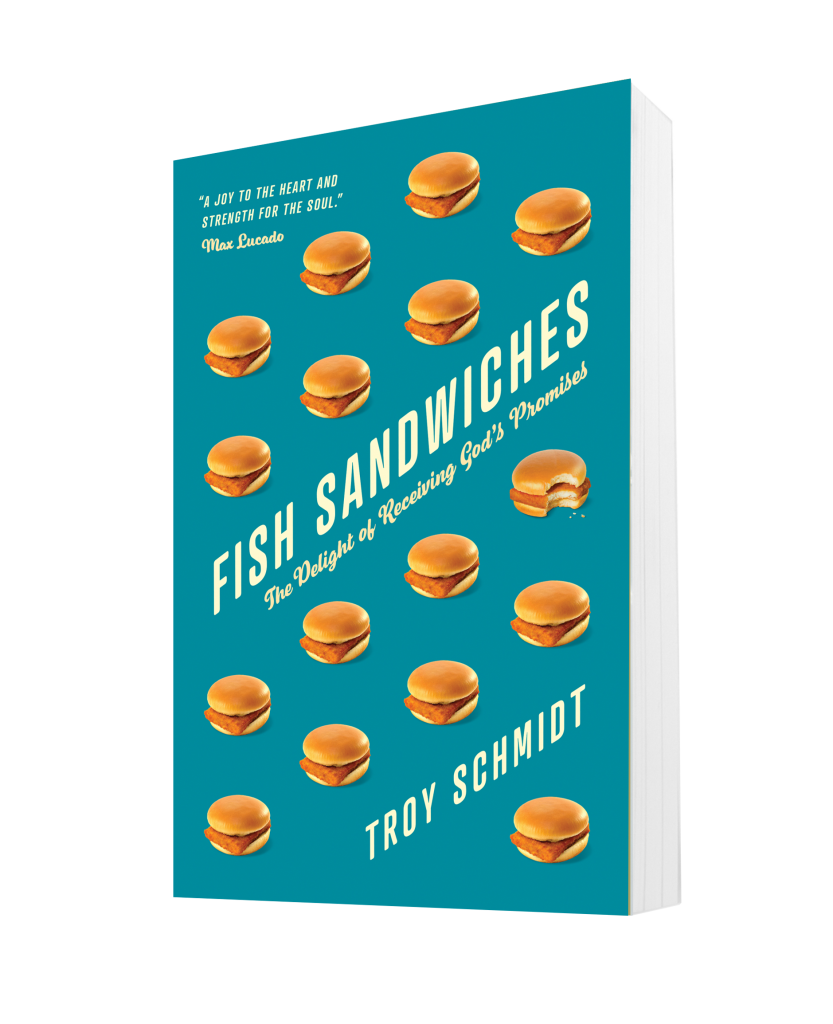
[i] The following description is a compilation of all four accounts found in Matthew 14:15-21, Mark 6:35-44, Luke 9:12-17, and John 6:1-13.
[ii] “Tabgha—Church of the Multiplication of the Loaves and the Fishes,” embassies,gov, accessed August 30, 2018, http://embassies.gov.il/MFA/IsraelExperience/history/Pages/Tabgha-%20Church%20of%20the%20Multiplication%20of%20the%20Loaves.aspx.
[iii] “Tabgha,” Bible Places, accessed August 27, 2018, https://www.bibleplaces.com/tabgha/.
[iv] “Church of the Primacy of Peter, Tabgha,” Sacred Destinations, accessed August 27, 2018, http://www.sacred-destinations.com/israel/tabgha-church-of-primacy-of-peter.
[v] The following is a compilation of the accounts found in Matthew 15:29-38 and Mark 8:1-9.
[vi] To read about Jesus healing the demon-possessed man, see Mark 5:1-20. For information about the area where this miracle occurred, see https://biblewalks.com/sites/kursi.html.
[vii] The mosaic tiles of the fish have been picked away by Muslims, who believe any pictures of animals constitute graven images or idols.
[viii] See Matthew 15:24.

